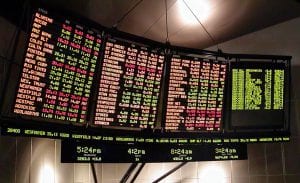 Feb 14, 2024
Feb 14, 2024
Seizing Opportunities: Sept 2015 Stock Market Crash
In the labyrinth of financial markets, the echoes of past crashes reverberate as grim reminders of the devastating fallout of unchecked optimism and widespread panic. The “Sept 2015 stock market crash” is a testament to this reality, yet it also offers profound insights into the art of seizing opportunities amidst the chaos.
Understanding the Sept 2015 Stock Market Crash: A Brief Overview
A storm was brewing in the global financial world during September 2015. The fury of this storm, the stock market crash, manifested an ominous amalgamation of factors. Predominantly, it was the increasing apprehension of a potential economic deceleration in China, a significant player in the world’s economy. This fear permeated across global markets like wildfire, intensifying the ensuing impact.
Additionally, the oil market, a cornerstone of the global economy, was undergoing turbulence, with prices free-falling. This added a layer of complexity and uncertainty to an already volatile situation, exacerbating fears and leading to a widespread market sell-off.
Meanwhile, the Federal Reserve, the United States central banking system, had a crucial role in this unfolding drama. Their decision to sustain interest rates near zero was a double-edged sword. On one hand, it was an attempt to stimulate the economy by encouraging borrowing and investing. On the other hand, it created an environment of uncertainty that further contributed to the market panic.
However, a silver lining emerged amidst the chaos and turmoil for the discerning investor. The market crash, though daunting, presented an opportunity to buy valuable stocks at reduced prices. As the saying goes, ‘Buy when there’s blood in the streets.’ While a significant economic event, the September 2015 stock market crash served as a stark reminder of the cyclic nature of markets and the potential opportunities that lurk within periods of uncertainty and fear.
Reading the Signs: Mass Psychology and Market Timing
Investing is a complex maze, with the successful navigation of its twists and turns hinging on a blend of art and science. Market timing is one of the most critical yet elusive components of this mix. It’s a skill akin to catching a wave in the ocean; it requires a deep understanding of the currents beneath the surface and the ability to anticipate the force and direction of the wave.
Underlying this skill is an intricate dance between technical analysis and mass psychology. Technical analysis provides a roadmap, charting the historical performance of stocks to predict future trends. It’s a mathematical approach, a blend of statistics and logic. It offers a solid foundation, but it’s not enough to navigate the unpredictable seas of investing.
Enter mass psychology. It’s the wild card, the unpredictable element that can drastically shift market trends. It’s the collective sentiment of investors, driven by fear, greed, and everything in between. During the Sept 2015 crash, fear triggered a mass sell-off. The market, driven by human emotion, stumbled and fell.
Yet, in this chaos, contrarian investors saw an opportunity. These are the individuals who swim against the tide, who buy when others are selling. They understand that panic often leads to undervaluation, and undervaluation signals a buying opportunity. Therefore, the mass panic of September 2015 presented a unique window for these contrarian investors to seize valuable assets at bargain prices. It’s a testament to the power of reading the signs, understanding mass psychology, and mastering the art of market timing.
The Technical Lens: Identifying Oversold Conditions
In the world of stock market investing, knowledge is power, and technical analysis provides a crucial toolkit for investors looking to understand and navigate market trends. One of the most potent weapons in this arsenal is the ability to identify oversold conditions.
Understanding the concept of oversold conditions requires a basic grasp of market dynamics. Essentially, a market is said to be ‘oversold’ when the price of an asset has fallen sharply and excessively due to aggressive selling, leading to a situation where the price is much lower than its intrinsic value. This typically happens during widespread panic and fear, as did during the September 2015 crash.
Investors employ various technical indicators to identify these oversold conditions, including the Moving Average Convergence Divergence (MACD), Stochastics, and the Relative Strength Index (RSI). These indicators, each with unique formulae and interpretive methods, serve as practical navigation tools in the volatile investing sea.
In September 2015, these indicators started flashing in unison, signalling that the markets were oversold. It was like a lighthouse guiding investors through the storm, indicating that a rebound was on the horizon despite the prevailing fear and panic.
This situation presented a golden opportunity for investors. Those who read the signs and brave the storm could buy valuable stocks at rock-bottom prices and reap the rewards when the market eventually rebounded. The September 2015 crash, therefore, serves as a stark reminder of the importance of understanding and utilising technical analysis to identify oversold conditions and seize potential buying opportunities.
Historical Parallels: From Tulip Mania to the 2015 Crash
The fascinating world of financial markets is no stranger to periods of extreme volatility, with history serving as a testament to the cyclical nature of these markets. One historical parallel that resonates with the 2015 crash is the infamous Tulip Mania of the 17th century. This speculative bubble swept through Europe, with tulip bulbs traded at extraordinarily high prices.
The dynamics of Tulip Mania echo eerily in the modern context. As with the 2015 crash, the tulip bubble burst triggered mass panic and a hasty sell-off. Prices plummeted, fear permeated the market, and the financial landscape was uncertain.
Yet, amidst this chaos emerged a sect of savvy investors who viewed the situation differently. These individuals understood that value often hides in plain sight when fear clouds the market’s judgment. They recognised that the market’s intrinsic value hadn’t changed despite the prevailing pessimism.
Leveraging this understanding, they entered the fray, buying assets at rock-bottom prices. Their reward came when the market eventually recovered, and their investments paid off handsomely.
The 2015 crash and Tulip Mania, disparate in time and context, share this fundamental lesson: periods of extreme pessimism often present the best buying opportunities. It’s a lesson in resilience, understanding, and strategic investment that has stood the test of time, from the tulip fields of 17th-century Europe to the digitally driven stock markets of the 21st century.
The 2015 Opportunity: A Case Study in Contrarian Investing
As the old saying goes, ‘fortune favours the bold,’ this couldn’t be more accurate when discussing the landscape of financial investing, particularly in the context of the September 2015 market crash. It represented a tumultuous period of fear, uncertainty, and rampant selling. The markets were in disarray, and pessimism was the order of the day.
Yet, amidst the financial chaos, a particular group of investors saw not a crisis but an opportunity. These were the contrarian investors, who operated outside the prevailing market sentiment and zig when others zagged. They understood the principles of mass psychology – that fear often leads to irrational selling and undervaluation of assets. They were well-versed in technical analysis, enabling them to identify the oversold conditions that signalled a potential market rebound.
While the masses were selling in fear, these contrarian investors confidently bought, acquiring assets at significantly depressed prices. Their strategy was not born out of unquestioning optimism but a calculated understanding of market dynamics and a belief in the cyclical nature of financial markets.
In the months that followed, their courage and strategic foresight were vindicated. As the market recovered, the assets they had acquired at rock-bottom prices began to appreciate, yielding substantial returns on their investments. This scenario served as a compelling case study in contrarian investing, demonstrating that sometimes, the most significant opportunities arise amidst widespread panic and fear. It’s a testament to the power of strategic foresight, understanding market psychology, and courage to go against the grain.
Conclusion: The Power of Perspective in Market Crashes
Like all market crashes, the Sept 2015 Stock Market Crash was a period of intense fear and uncertainty. Yet, it was also a period of immense opportunity. By understanding the principles of mass psychology and technical analysis and maintaining a contrarian perspective, investors can turn market crashes into opportunities for significant gains.
In the grand tapestry of financial markets, crashes are inevitable. Yet, as the Sept 2015 crash demonstrates, these periods of turmoil can also present unique opportunities. As investors, our challenge is recognising and seizing these opportunities, even – or perhaps significantly – when others are too fearful to do so.
The next time you hear the phrase “Stock Market Crash,” remember the lessons of September 2015. Embrace the power of perspective, understand mass psychology and technical analysis signals, and seize the opportunities that market crashes can present. After all, fortune indeed does favour the brave in the world of investing.
Explore the Unconventional: Challenge the Norm
Bull Bear Traders-Long Term Stock Market Bears Always Lose
Brexit’s Currency Wars: Hidden Theme for Financial Freedom
Surviving the Bear Stock Market: What’s New for Investors?
Fed Interest Rate: Negative Rates Are A Game Changer
What Economic Recovery? Most Americans Lack $1000 In Savings
Federal Reserve Interest Rate: Dangers & Benefits of Negative Rates

Why Are Interest Rates So Low: Coronavirus That’s Why
CAT Stock Price Projections And Future Trends
Why own gold in uncertain times: Protection From Disaster
HD stock quote And future price trends
Valeant Shares Slump



 Feb 14, 2024
Feb 14, 2024